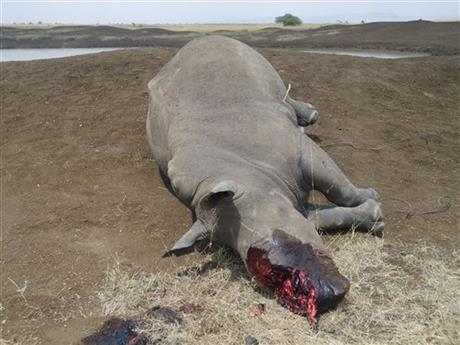
By JASON STRAZIUSO
EDITORS NOTE GRAPHIC IMAGE – In this photo of Sunday Aug. 10, 2013 provided by Kenya Wildlife Services a dead rhino killed by poaches in Nairobi National park is seen. Kenyan Wildlife Service officials say armed poachers shot and killed a white rhino and cut off its horn, the first poaching death of a rhino in the urban park in six years. Nairobi resident Chris Donohue said Tuesday Aug. 13, that he and his family saw the poached rhino during a safari drive on Sunday. Donohue said the sighting was “pretty traumatic” and showed how endangered rhinos are. The killing brings to 35 the number of rhinos killed in Kenya so far this year, a sharp rise from the 29 killed in total in 2012.(AP Photo/Kenya Wildlife Services)
NAIROBI, Kenya (AP) — Chris Donohue was driving his wife and kids through the world’s only safari park that borders a major city last weekend when they found a prized sighting: three male lions close together. Then the Donahues saw why. Nearby a rhino lay dead, its horn sliced off and stomach opened up.
Donohue, an American who lives in Nairobi, said Tuesday that the sight made him nauseous.
“The kids were like, ‘Daddy, was that rhino sick?’ And we were like, no, we’re pretty sure it was poached,” said Donahue, who takes his kids to Nairobi National Park several times a year. “For me it was pretty traumatic to see it.”
Gun-wielding poachers slaughtered the pregnant rhinoceros while it stood near a watering hole Friday. It was the first killing of a rhino in Nairobi National Park in six years, the Kenya Wildlife Service said.
“It shows the great heights these criminals are willing to go,” said Paul Udoto, the wildlife service’s spokesman. “It’s something we are taking very seriously because it’s a new level of poaching for us. And it is indeed very daring.”
The killing is the latest case in a worrying poaching trend, as demand in China and other Asian countries for elephant ivory and rhino horn increases. Kenya saw 29 rhinos killed by poachers last year. This year 35 have already been killed.
One reason poachers may not fear carrying out the illegal killings is that Kenya’s anti-poaching laws are antiquated and weak. When four Chinese men pleaded guilty in January to charges of smuggling ivory, they received no jail time and were fined less than $400 each, money that pales in comparison to the tens of thousands of dollars smuggled ivory will sell for in Asia.
That could now be changing, though. Kenya’s parliament is expected next month to take up a wildlife bill with greatly increased jail terms and fines. KWS said in a statement to The Associated Press that it is “most pleased” with the bill’s increased penalties for wildlife crime.
The proposed bill in its latest form calls for a minimum fine of nearly $115,000, or a minimum prison term of 15 years — or both — for a person who commits crimes related to endangered or threatened species. Those in possession of wildlife trophies face a minimum fine of nearly $15,000 or five years in prison or both. Sport hunters also face harsher penalties.
“It is important for the simple reason that one of the biggest challenges is the lenient penalties we have,” said Martin Mulama, chief conservation officer at Ol Pejeta, a private animal sanctuary near Mt. Kenya that holds both elephants and rhinos. “If this goes through, because the proposed penalties are harsher, we will see it as a bigger deterrent to poaching.”
The White House said in a statement last month that wildlife trafficking is a multi-billion dollar business that is “decimating” Africa’s iconic animal populations. President Barack Obama, during a July trip to Tanzania, Kenya’s neighbor to the south, announced $10 million in training and technical assistance to combat wildlife trafficking, including $3 million for Kenya.
In addition to increasing judicial penalties, Mulama said Kenya must improve how law enforcers collect evidence and how prosecutors perform in court.
“We have been trying our best to sensitize Kenyans who look at wildlife as being for someone else, for the government or people with private ranches,” he said. “But we should sit back and say, ‘This is our heritage. We all have a role to play.’ … As much as the demand comes from China and Asia, it is the locals that carry out the act of poaching.”
Kenya’s government is upping its animal defenses. Earlier this month it announced the formation of an inter-agency unit to be deployed to poaching hotspots.
“Urgent and decisive action now needs to be taken to eliminate the escalating poaching crisis which has now become both a national and economic issue,” said Judi Wakhungu, the cabinet secretary for the Ministry of Environment, Water and Natural Resources.
Kenya has lost 190 elephants and two rangers to poachers this year. Over the last three years about 1,000 elephants have been killed by poachers. Kenya’s elephant population is between 35,000 and 40,000 elephants, says the Kenya Wildlife Service. A ranger was injured by gun-wielding poachers in Lake Nakuru National Park last weekend.
Donohue, the American whose family saw the poached rhino carcass on Sunday, likes to drive through the Nairobi park at sunrise several times a year. Those visits may never be the same.
As Donohue drove out of the park, his family saw armed rangers on foot who were shadowing another rhino. Later they passed a truck full of armed rangers. “In hindsight they were downtrodden and really serious,” he said
“My young son, the 3-year-old, while we were driving away from the dead rhino he was like, ‘Daddy, all the rhinos be dead,” Donohue said. “It sort of hits home, how endangered these things are.”



